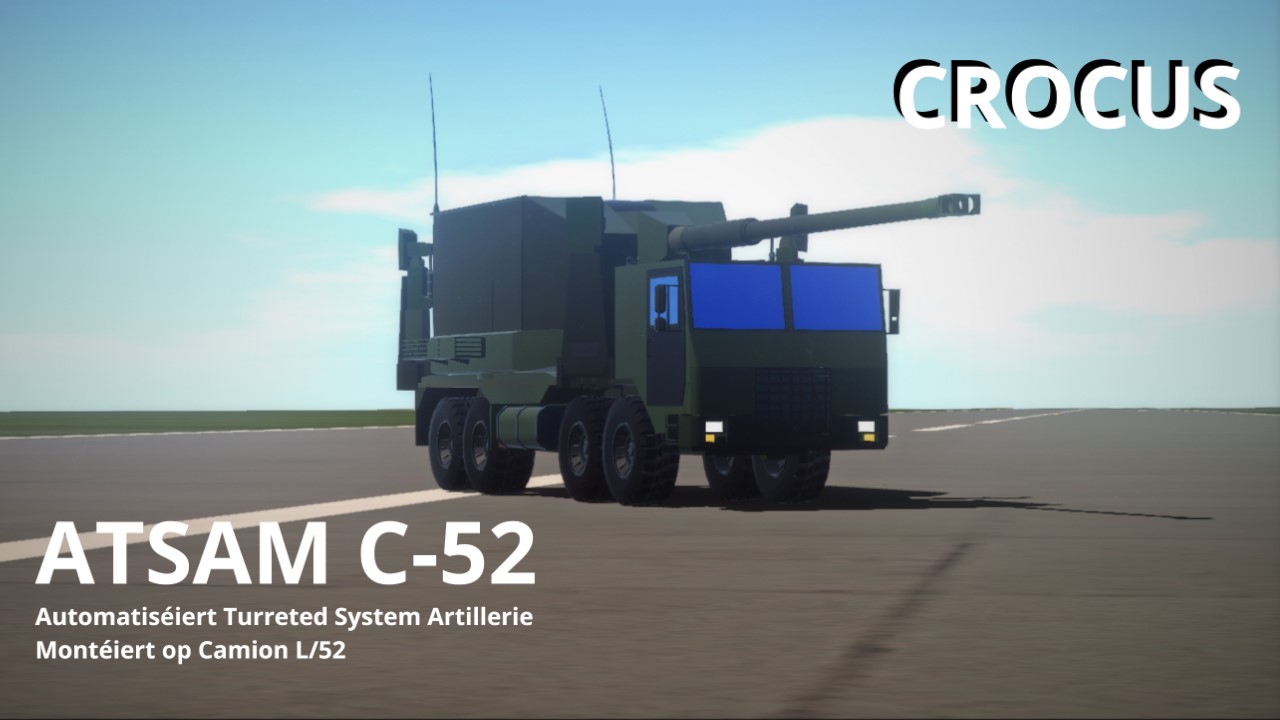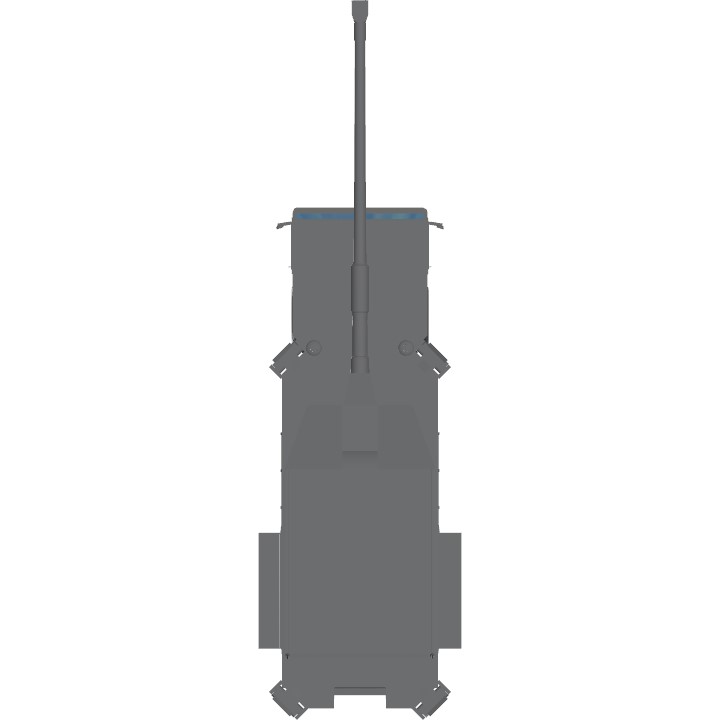
Description.
The ATSAM C-52 'Crocus' is a cutting-edge truck-mounted howitzer artillery system developed by BlackGearCompany. Named after the Crocus flower, this system combines advanced technology with robust design.
Equipped with a 155mm NATO howitzer with a barrel length of L/52 (8.06 meters), the Crocus can engage targets up to 40 kilometers away. Its dimensions—3.7 meters high, 9 meters long, and 3.6 meters wide—allow for efficient operation, although it lacks significant armor, making it more suitable for rear-line deployment. Armor upgrades (STANAG 3) can enhance crew protection against small-caliber fire.
The Crocus offers a wide range of ammunition options, including HE, HEAT, and guided munitions like the M982 Excalibur. It requires only 2-3 crew members, who can operate it remotely or directly from the cabin, similar to an Artillery Gun Module (AGM). Artillery reconnaissance teams provide real-time data to ensure accurate targeting.
Designed for cross-country mobility, the Crocus navigates rough terrains effectively. While early models faced stability issues, improvements have been made. It features an AWD system and a turbo diesel V8 engine from Scania, delivering 350 horsepower and a top speed of 90 km/h with an 850 km range.

Control
Pitch & Roll : Move forward and roll.
AG-1 : For Legs stabilizers
Trim & VTOL : Turret control
For Trim and Control, after adjusting, put back the bar
Or else its gonna take a time to adjusting it back
Overview
Name : ATSAM C-52 ‘Crocus’
Place Origin : Luxembourg
Type : Self-Propelled Howitzer
In Service : 2019 – Future ahead
Designed : 2015 – 2017
Operator : Luxembourg, USA, Ukraine and +6 countries.
Manufacturers : BlackGearCompany and KNDS
Designer : BlackGearCompany and KNDS
Partnership : Rheinmetall and KNDS
Number Built : 65+ (2024)
Specification
Mass : 37,000 Kg
Length : 13m (Include barrel)
Height : 3.7m
Width : 3,6m
Wheel Type : 8x8 AWD
Engine : Turbo Diesel V8 Scania Licensed Engine
Maximum Speed : 90km/h
Operational Range : 850km


Lore
Ive decide to put the lore into the forum... Or never at all.
Timeline
2007 – Market Demand: A rise in demand for mobile, cross-country-capable Self-Propelled Howitzers (SPH) with high mobility leads BGC to explore wheeled chassis options. Competitors like the Atmos 2000 and Zuzana/DANA serve as benchmarks.
2008 – Initial Proposal: BGC submits a development proposal for a Truck Mounted Howitzer (TMH) to headquarters, targeting a wheeled SPH design. The proposal is declined due to limitations in technology, tooling, and collaboration networks.
2014 – Establishing Partnerships: To overcome past challenges, BGC visits KNDS (KMW and Nexter) and Rheinmetall, exploring collaborative opportunities. Key agreements are discussed, laying the groundwork for shared expertise and technology exchange, particularly for modular artillery components.
2015 – Early Development Phase:
- February: BGC submits refined proposals based on partner feedback, emphasizing scalability and modularity.
- March: After thorough evaluation, one proposal is selected for initial development, followed by months of planning and preparation.
2016 – Component Integration: BGC incorporates KMW’s Artillery Gun Module (AGM) components into the Crocus design, selectively adapting features to meet criteria for a rapid-deployment, cost-effective, and modular SPH. Customizations aim to balance operational readiness with affordability.
2017 – Prototype Testing and Troubleshooting: The first operational testing phase reveals issues like uneven weight distribution, compromising stability at speeds over 30 km/h. Partner companies supply test vehicles, including BGC’s Wil-12 8x8, to evaluate various configurations and resolve these flaws.
2018 – First Batch Production and Feedback: BGC produces an initial batch of 10 units. Field tests confirm stability issues, especially on sharp turns. Comprehensive evaluations are initiated. In November, orders are placed by the U.S. and Luxembourg for testing.
2019 – Enhanced Production:
- Following refinements, a second batch is produced. Mid-year, 5 units are shipped to the U.S., while 4 of 15 units ordered by Luxembourg are delivered. Testing feedback leads to additional modifications before the next delivery scheduled for March 2020.
2020 – Mass Production and Global Orders: Crocus enters full production. Orders come from Ukraine (18 units), the Philippines (6), Indonesia (5), and Denmark (8). Given the demand, BGC collaborates with KNDS and Rheinmetall for production scaling and timely delivery.
2021 – First Combat Engagement:
A shipment to the Philippines comes under attack by Yemeni Houthi militants using kamikaze drones. The ship’s AEW helicopter detects the threat nearly a hundred mile away, giving crucial advance warning. In a unique defensive maneuver, one Crocus TMH, which already unpacked, is activated temporarily to intercept. The crew frantically loads proximity-fused rounds and, remotely controlling the system from within the cabin, manages to neutralize the threat after expending almost 15 rounds, bolstering Crocus’s reputation for versatility.
2022 – Operational Highlight in Ukraine: As Russia invades Ukraine, Crocus receives notable attention for its effectiveness in supporting Ukrainian defenses. Multiple nations, recognizing its reliability, place orders for additional units.
2023 – Global Deployment and Combat Reputation: Crocus’s performance in Ukraine and the Middle East gains further media coverage. Some units in Ukraine show battle wear and even enemy capture, yet the system's durability remains well-regarded. Some allies donate Crocus units to support Ukrainian forces.
2024 – Lebanese-Israeli Conflict: Crocus is deployed by Lebanon in response to an Israeli incursion. The SPH proves formidable, with units reportedly neutralizing four Merkava tanks, significantly impacting the battlefield and marking Crocus as a notable anti-armor artillery asset.
Specifications
Spotlights
- YarisSedan 5 months ago
- ChihiroFujisaki 5 months ago
- SILVERPANZER 5 months ago
- KPLBall 5 months ago
- dabestsock 5 months ago
General Characteristics
- Created On Windows
- Wingspan 11.7ft (3.6m)
- Length 41.6ft (12.7m)
- Height 18.3ft (5.6m)
- Empty Weight 79,404lbs (36,017kg)
- Loaded Weight 80,683lbs (36,597kg)
Performance
- Wing Loading N/A
- Wing Area 0.0ft2 (0.0m2)
- Drag Points 11431
Parts
- Number of Parts 471
- Control Surfaces 0
- Performance Cost 2,171






@dabestsock Thanks!
Cool
Sorry yall, it's taking long time, i've been a bit busy. I know it's not perfect to expectations, but this one is only thing i can do for this day.
Tags
@126